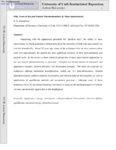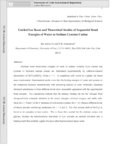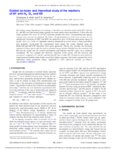|
|
Creator | Title | Description | Subject | Date |
| 76 |
 |
Miller, Joel Steven; Epstein, Arthur J. | Ferrimagnetic resonance in films of vanadium [tetracyanoethanide]x, grown by chemical vapor deposition | Ferrimagnetic resonance (FMR) measurements in thin films of V[TCNE]x grown by chemical vapor deposition exhibit a series of sharp lines at 300 K. The orientational dependence of these lines is a result of the sample geometry provided the magnetization tracks the applied magnetic field. The FMR inten... | Spin; Anisotropy; Magnetization | 2004 |
| 77 |
 |
Miller, Joel Steven; Epstein, Arthur J. | Ferromagnetic behavior and magnetic excitations in a molecular-based alternating-spin chain: decamethylchromocenium tetracyanoethenide | We report the study of magnetic properties of a molecular-based alternating-spin chain: metallocenium electron-transfer salt decamethylchromocenium tetracyanoethanide, [CrCp(*2)] [TCNE]. We give a modified spin-wave theory for the Heisenberg alternating-spin chains. The low-field susceptibility and... | TCNE; Magnetization | 1994 |
| 78 |
 |
Miller, Joel Steven; Epstein, Arthur J. | Ferromagnetic behavior of decamethylchromocenium tetracyanoethenide, [CrCp*2][TCNE] | Studies on the magnetic properties of decamethylchromocenium tetracyanoethanide, [CrCp*2][TCNE] are reported herein. Near-zero field (H= 150 mG) data indicates a ferromagnetic transition with T(c)=3.65 K. The temperature dependence below T(c) can be fit to a mean-field result M=M(o)(1 - T(o))(1/2)... | Magnetic; Magnetization; Transition | 1993 |
| 79 |
 |
Miller, Joel Steven; Epstein, Arthur J. | Ferromagnetic properties of one-dimensional decamethylferrocenium tetracyanoethylenide (1:1): [Fe(n5-C5Me5)2].+[TCNE].- | [Fe(C5Me5)2].+ [TCNE].-- has been characterized by magnetic susceptibility to possess dominant ferromagnetic interactions; its structure has been determined by X-ray crystallography. | Susceptibility; Crystal; Magnetic | 1986 |
| 80 |
 |
Miller, Joel Steven; Epstein, Arthur J. | Ferromagnetism in molecular decamethylferrocenium tetracyanoethylenide: (DMeFc TCNE) | The temperature and magnetic field dependence of the magnetization and susceptibility of single-crystal decamethylferrocenium tetracyanoethenide demonstrate that this material is the first molecular compound with a ferromagnetic ground state. A spontaneous magnetization is observed for T < 4.8 K. T... | Magnetization; Ferromagnetic | 1987 |
| 81 |
 |
Miller, Joel Steven; Epstein, Arthur J. | Ferromagnetism in molecular materials: decamethylferrocenium tetracyanoethanide [DMeFc][TCNE] (invited) | Ferromagnetism has only recently been observed in molecular materials. We present here a summary of the ferromagnetic phenomena observed in the molecular charge transfer salt, decamethylferrocenium tetracyanoethanide (DMeFc) (TCNE), and related compounds. A spontaneous magnetization is observed i... | Magnetic; Magnetization | 1988 |
| 82 |
 |
Armentrout, Peter B. | Fifty years of ion and neutral thermochemistry by mass spectrometry | Originating with the appearance potentials for "positive rays", the ability of mass spectrometry to obtain quantitative information about the energetics of both ions and neutrals has evolved dramatically. About 50 years ago, many of the techniques that are now common place were first implemented, th... | | 2014-01-01 |
| 83 |
 |
Morse, Michael David | First spectroscopic investigation of the 4 d transition metal monocarbide MoC | The first optical spectroscopic investigation of MoC has revealed a complicated vibronic spectrum consisting of about 35 bands between 17 700 and 24 000 cm-1. Analysis has shown the ground state to be the ?=0+ spin?orbit component of a 3?- state that derives from a 10?211?25rr42d 2 configuration. Th... | | 1998 |
| 84 |
 |
Miller, Joel Steven | Formation of Ni[C4(CN)8] from the reaction of Ni(COD)2 (COD = 1,5-cyclooctadiene) with TCNE in THF | The dissolution of Ni(COD)2 (COD = 1,5-cyclooctadiene) into dichloromethane leads to decomposition and formation of a room temperature magnetic material, whereas the reaction of Ni(COD)2 and tetracyanoethylene (TCNE) in THF forms paramagnetic materials including NiII[C4(CN)8](THF)2.xTHF. These resu... | Dinuclear complexes | 2007 |
| 85 |
 |
Miller, Joel Steven | Formation of a zwitterionic donor-acceptor compound based on N,N,N',N'-tetramethly-p-phenylenediamine and 7,7,8,8-tetracyanoperfluoro-p-quinodimethane | The reaction of the donor N,N,N',N'- tetramethyl-p-phenylenediamine (TMPD) with the acceptor 7,7,8,8-tetracyanoperfluoro-p-quinodimethane (TCNQF4) has led to the isolation of a novel type of zwitterionic donor-acceptor compound whose structure has been determined by X-ray crystallography. | Ccrystals; Single bond | 1988 |
| 86 |
 |
Miller, Joel Steven; Epstein, Arthur J. | Forthcoming attractions | Magnets made from molecules and ions having spins in p orbitals have only been discovered in the past decade. Their solubility in organic solvents and room temperature manufacture means that they should find a variety of applications. | Electron; Temperature; Magnets | 1994 |
| 87 |
 |
Armentrout, Peter B. | Fragmentation reactions of thiourea- and urea-compounds examined by tandem MS-, energy-resolved CID experiments, and theory | Fragmentation reactions of thiourea- and urea-compounds, which are promising reagents for chemical crosslinking (XL), are investigated in detail by collision-induced dissociation (CID) experiments in a quadrupole ion trap (QIT), energy-resolved CID experiments, and computational modeling. For this s... | | 2012-01-01 |
| 88 |
 |
Voth, Gregory Alan | Further developments in the local-orbital density-functional-theory tight-binding method | Quantum-mechanical methods have become increasingly reliable as a complementary tool to experimental research. A variety of methods exist ranging in complexity from semiempirical methods to density-functional-theory (DFT) methods [using either the local-density approximation (LDA) or the generalize... | Sankey-Niklewaki method; Fireball method; Pseudopotential; Exchange-correlation interactions; Gallium nitride; H20 dimer; Copper; gas-phase HMX | 2001-10 |
| 89 |
 |
Armentrout, Peter B. | Guided ion beam and theoretical studies of sequential bond energies of water to sodium cysteine cation | Absolute bond dissociation energies of water to sodium cysteine (Cys) cations and cysteine to hydrated sodium cations are determined experimentally by collision-induced dissociation of Na+Cys(H2O)x, where x = 1 - 4, complexes with xenon in a guided ion beam mass spectrometer. Experimental results sh... | | 2010-01-01 |
| 90 |
 |
Armentrout, Peter B. | Guided ion beam and theoretical studies of the reaction of Ag+ with CS2: gas-phase thermochemistry of AgS+ and AgCS+ and insight into spin-forbidden reactions | The gas-phase reactivity of the atomic transition metal cation, Ag+, with CS2 is investigated using guided-ion beam mass spectrometry. Endothermic reactions forming AgS+ and AgCS+ are observed but are quite inefficient. This observation is largely attributed to the stability of the closed shell Ag+(... | | 2010 |
| 91 |
 |
Armentrout, Peter B. | Guided ion beam and theoretical studies of the reaction of Ru+ with CS2 in the gas-phase: thermochemistry of RuC+, RuS+, and RuCS+ | Abstract: The gas-phase reactivity of the atomic transition metal cation, Ru+, with CS2 is investigated using guided-ion beam mass spectrometry (GIBMS). Endothermic reactions forming RuC+, RuS+, and RuCS+ are observed. Analysis of the kinetic energy dependence of the cross sections for formation of ... | | 2010 |
| 92 |
 |
Armentrout, Peter B. | Guided ion beam and theoretical study of the reactions of Au+ with H2, D2, and HD | Reactions of the late third-row transition metal cation Au+ with H2, D2, and HD are examined using guided ion beam tandem mass spectrometry. A flow tube ion source produces Au+ in its 1S (5d10) electronic ground state level. Corresponding state-specific reaction cross sections for forming AuH+ an... | | 2011 |
| 93 |
 |
Armentrout, Peter B. | Guided ion beam and theoretical study of the reactions of Hf+ with H2, D2, and HD | The kinetic energy dependences of reactions of the third-row transition metal cation Hf+ with H2, D2, and HD were determined using a guided ion beam tandem mass spectrometer. A flow tube ion source produces Hf+ in its 2D (6s25d1) electronic ground state level. Corresponding state-specific reaction c... | | 2010-01-01 |
| 94 |
 |
Armentrout, Peter B. | Guided ion beam and theoretical study of the reactions of Os + with H 2, D 2, and HD | Reactions of the third-row transition metal cation Os+ with H2, D2, and HD to form OsH+ (OsD+) were studied using a guided ion beam tandem mass spectrometer. A flow tube ion source produces Os+ in its 6D (6s15d6) electronic ground state level. Corresponding state-specific reaction cross sections are... | | 2011 |
| 95 |
 |
Armentrout, Peter B. | Guided ion beam studies of the reaction of Nin+ (n=2-16) with D2: nickel cluster-deuteride bond energies | The kinetic-energy dependences of the reactions of Nin+ (n=2-16) with D2 are studied in a guided ion beam tandem mass spectrometer. The products observed are NinD+ for all clusters and NinD2 + for n=5-16. Reactions for formation of NinD+ are observed to exhibit thresholds, whereas cross sections for... | Metal clusters; Nickel ions; Bond energies; Deuterides; Collision-induced dissociation; Endothermic reactions | 2002 |
| 96 |
 |
Armentrout, Peter B. | Guided ion beam studies of the reactions of Crn + (n=2-18) with O2: chromium cluster oxide and dioxide bond energies | The kinetic energy dependence of the reactions of Crn+ (n=2-18) with O2 are studied in a guided ion beam mass spectrometer. A variety of CrmO2+, CrmO+, and Crm+ product ions, where m≤n, are observed, with the dioxide cluster ions dominating the products for all larger reactant cluster ions. React... | Metal clusters; Chromium ions; Oxygen; Oxygen; Bond energies; Exothermic reactions | 1998 |
| 97 |
 |
Armentrout, Peter B. | Guided ion beam studies of the reactions of Crn+ (n=1-18) with CO2: chromium cluster oxide bond energies | The kinetic energy dependence of the reactions of Crn+ (n=1-18) with CO2 are studied in a guided ion beam mass spectrometer. The primary product ions are CrnO+, which then decompose by sequential loss of chromium atoms as the kinetic energy is increased. Simple collision-induced dissociation to form... | Metal clusters; Chromium ions; Oxygen; Bond energies; Exothermic reactions; Endothermic reactions | 1998 |
| 98 |
 |
Armentrout, Peter B. | Guided ion beam studies of the reactions of Nin+ (n=2-18) with O2: nickel cluster oxide and dioxide bond energies | The kinetic energy dependences of the reactions of Nin + (n=2 - 18) with O2 are studied in a guided ion beam tandem mass spectrometer. A variety of NimO2+, NimO+, and Nim+ product ions, where m<n, are observed, with the dioxide cluster ions dominating the products for all larger reactant cluster io... | Metal clusters; Nickel oxide; Nickel dioxide; Bond energies; Collision-induced dissociation; Exothermic reactions | 2003 |
| 99 |
 |
Armentrout, Peter B. | Guided ion beam studies of the reactions of Vn+ (n = 2-13) with D2: cluster-deuteride bond energies as a chemical probe of cluster electronic structure | The kinetic energy dependencies of the reactions of Vn+ (n=2 - 13) with D2 are studied in a guided ion beam tandem mass spectrometer. Products observed are VnD1 for all clusters and VnD2 + for n=4 - 13. All reactions are observed to exhibit thresholds, except for formation of VnD2 + for n =4,5,7,9,1... | Metal clusters; Vanadium ions; Bond energies; Endothermic reactions; Collision-induced dissociation; Transition metal ions; Deuterides | 2002 |
| 100 |
 |
Armentrout, Peter B. | Guided ion beam study of collision-induced dissociation dynamics: integral and differential cross sections | The low energy collision-induced dissociation (CID) of Cr(CO)6+ with Xe is investigated using a recently modified guided ion beam tandem mass spectrometer, in the energy range from 0 to 5 eV in the center-of-mass (CM) frame. The additions to the instrument, updated with a double octopole system, and... | Collision-induced dissociation; Bond energies; Chromium carbonyl; Xenon | 2001 |

























